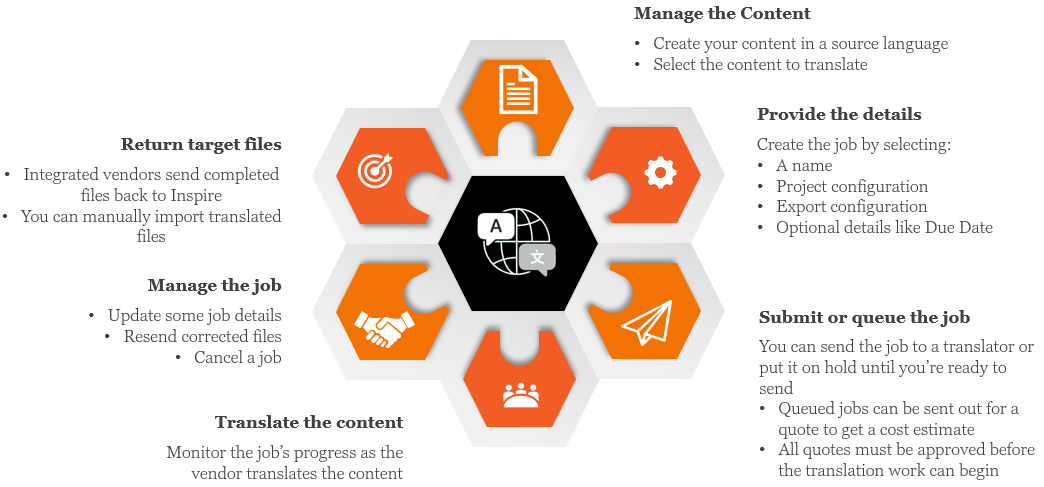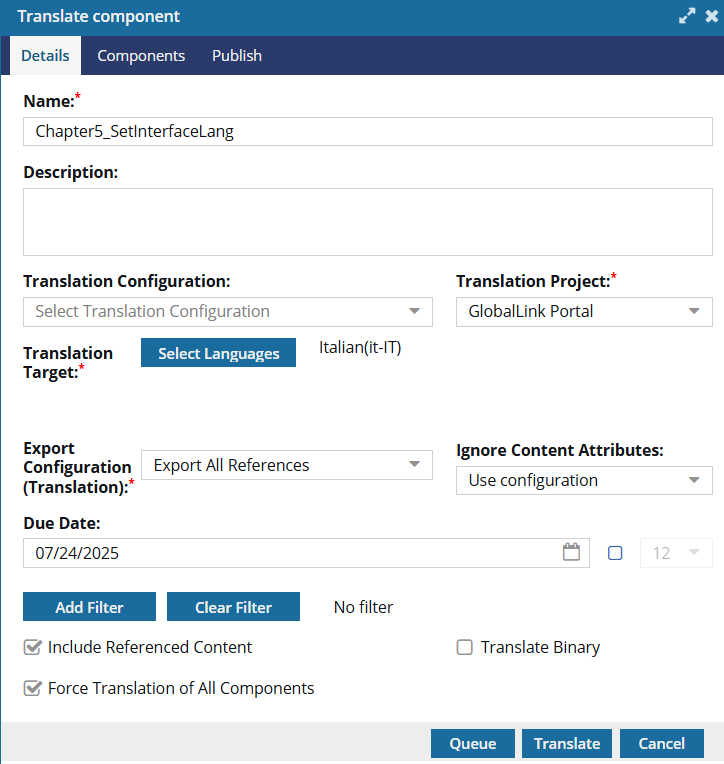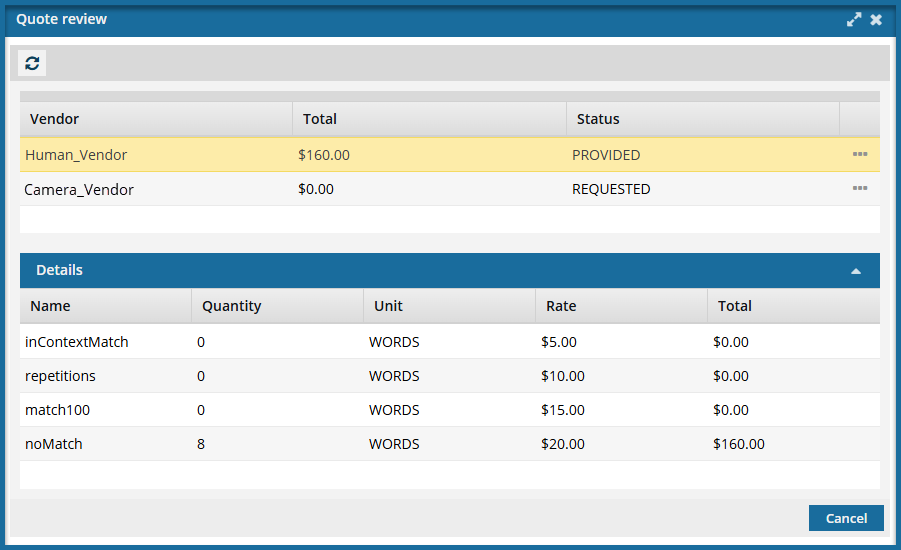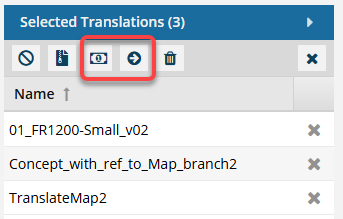Understand the translation process
In Inspire, the translation process is basically the same no matter where the translation work is being done.



 In Inspire, you create the component(s) you want to send to translation.
In Inspire, you create the component(s) you want to send to translation.
- Components browser
- Projects Management

 You create the translation job. You must select the languages and how you want to export the files for translation. You can access the Translate option in the following places:
You create the translation job. You must select the languages and how you want to export the files for translation. You can access the Translate option in the following places:
- Components browser
- From a single component's
 Options menu
Options menu - From the
 Selected Components panel
Selected Components panel
- From a single component's
- Projects Management
- From a single component's
 Options menu
Options menu - From the
 Selected Components panel
Selected Components panel
- From a single component's
 An administrator can limit a translation coordinator to selecting only approved components to include in a translation job.
An administrator can limit a translation coordinator to selecting only approved components to include in a translation job.  Restrict translation to approved components.
Restrict translation to approved components.



 You can choose what to do with your translation job; either start to Translate or Queue the job.
You can choose what to do with your translation job; either start to Translate or Queue the job.
 You can queue jobs for all types of Translation Projects.
You can queue jobs for all types of Translation Projects.
- First, Inspire prepares the job.
- Inspire creates a folder for each language you select. The folder's location is based on the component you select for translation. For example:
- If you select a component in the following folder and want to translate it to French: My Components / Chapter 1
- Then Inspire creates a sub folder here: My Components / Chapter 1 / fr-FR
- Inspire creates a copy of the component you want translated and puts it into the new language folder. A new copy, also known as the target translation component, is created for each language you selected.
- For example, the My Components / Chapter 1 / fr-FR folder now has a copy of the Introduction component you selected: My Components / Chapter 1 / fr-FR / introduction_fr-FR.xml
 Inspire may set the Reading property when creating target components for translation.Inspire sets the Reading property in these cases:
Inspire may set the Reading property when creating target components for translation.Inspire sets the Reading property in these cases:- If it doesn't exist yet
- Only if the language Reading property is rtl (Right-to-Left)
- For example:
<concept id="concept_guid" xml:lang="ar-Ar" dir="rtl"> - Inspire makes no changes if the language Reading property is ltr (Left-to-Right)
- For example, the My Components / Chapter 1 / fr-FR folder now has a copy of the Introduction component you selected: My Components / Chapter 1 / fr-FR / introduction_fr-FR.xml
- Inspire locks the source files being sent to translation. By default, source components are locked, however, you may see something different from the default behavior.
 An administrator can allow files that are in translation to be unlocked:
An administrator can allow files that are in translation to be unlocked:- Set the optional feature TranslationLockSourceDisabled to true.
 Allow files to remain unlocked during translation
Allow files to remain unlocked during translation - Add users or roles to the can_unlock_system module property to allow files to be unlocked while in translation.
 Control who can unlock system locks
Control who can unlock system locks
- Set the optional feature TranslationLockSourceDisabled to true.
- Inspire creates a folder for each language you select. The folder's location is based on the component you select for translation. For example:
- If you select Translate:
- If you're using an integrated vendor, Inspire contacts them and delivers the files and job settings. The integrated vendor provides Inspire with an ID that allows Inspire to track the job's progress.
- If you're using a manual process, you receive a notification with a link. The translation job content can be downloaded from that link. Then you must send the target files to the vendor for translation and provide them with the job details.
- In the Translations module, on the Translation Management screen, the State is set to In Progress.
- If you select Queue:
- In the Translations module, on the Translation Management screen, the State is set to Queued Submission.
- You must select this job and choose to Submit it to start the translation work with the vendor.
 Create a queued translation job
Create a queued translation job Queued jobs can be sent out to get a quote on the cost of translation work if an administrator has configured it.
Queued jobs can be sent out to get a quote on the cost of translation work if an administrator has configured it. 
- In GlobalLink Enterprise, an administrator must configure the associated Translation Project.
- In Inspire, an administrator must configure a Translation Integration Method to allow the use of quotes.
 Enable quotes for translation projects
Enable quotes for translation projects - After queuing a translation job, a Translation Coordinator can Work with quotes.
 If you send a request for a quote, you cannot manually submit the queued job to start the translation work.
If you send a request for a quote, you cannot manually submit the queued job to start the translation work.- You must wait for a quote to be provided.
- After you select Send for a quote, the queued job's
 Options menu no longer contains the Submit action. You see an option for Quote review instead of the Submit action.
Options menu no longer contains the Submit action. You see an option for Quote review instead of the Submit action. - If you select multiple Queued Submission jobs to send for a quote, and at least one job does not use a Project that allows for the quote feature, you will see the Send for Quote and the Submit button in the Selected Translations panel.

 If one of the jobs is not appropriate for the button you select, Inspire will perform the button's action on the appropriate jobs, and the other jobs are skipped.
If one of the jobs is not appropriate for the button you select, Inspire will perform the button's action on the appropriate jobs, and the other jobs are skipped.- To get a quote for the jobs that use a quote Project, select
 Send for quote.
Send for quote.- Any Queued Submissions that don't use the Quote feature are ignored.
- If you click
 Submit:
Submit: - The jobs that have a State of Queued and use the Quote feature are submitted. After the queued job is submitted, the Quote feature cannot be used with this job.
- The jobs that have a State of Quoted are ignored and are not changed in any way.
- All Queued Submissions are started whether or not they use the Quote feature.
- To get a quote for the jobs that use a quote Project, select
- You must approve a quote for work to start.


 While content is being translated, you can monitor the job's progress:
While content is being translated, you can monitor the job's progress:
- If you're using an integrated vendor, go to the Translations module, on the Translation Management screen. Inspire uses the following States:
- Created: The submission has been created in GlobalLink Enterprise.
- Queued Submission: The job has been prepared and then put on hold without contacting GlobalLink Enterprise.
- Quoted Submission: A user has requested a quote for a queued translation job. The quote has not been provided and approved yet.
- Exporting: Inspire is preparing the translation package to send to GlobalLink Enterprise.
- In Progress (previously, At Vendor): All files in a job have been sent to GlobalLink Enterprise.
- Translating: GlobalLink Enterprise is creating the translated versions of the source files.
- Cancelled
- Partially Completed (previously In Progress): when a subset of the files have been sent back to Inspire.
- Completed: All files in all languages have been translated and sent back to Inspire.
- Failed Retrieving: May indicate the following issues:
- This submission isn't done. Check the file's transfer progress in GlobalLink Enterprise.
- The translation file may have been corrupted during transmission. Check the file in GlobalLink Enterprise and if it's OK then resend it to Inspire
- If you're using a manual process, you must contact your vendor outside of Inspire.


 As the translation work is being done, issues may arise that you need to manage. Inspire allows to update translation jobs in the following ways:
As the translation work is being done, issues may arise that you need to manage. Inspire allows to update translation jobs in the following ways:
- Update translation details. You can only change some of the translation job properties.
- If a job is in the Translation state, you can change:
- On the Details tab: Name (of the job), Description, and (Translation) Coordinator
- On the Languages tab: Cancel (a language)
- On the Components tab: Cancel (a component translation)
- On the Integration tab: nothing
- On the Reference only tab: nothing
- If a job is in the Translation state, you can change:
- Force a translation job to be Completed. If a job contains a mix of cancelled and completed components, an Administrator can force the entire job to have a State of Completed. This also unlocks all files in translation.
- Resend corrected files using GlobalLink Portal. If a vendor finds an issue, you can correct and resend files that are still being translated or that are completed.
Resend corrected files using GlobalLink Portal
 GlobalLink Portal was formerly known as GlobalLink Transport.
GlobalLink Portal was formerly known as GlobalLink Transport. Resend completed files to GlobalLink Enterprise
Resend completed files to GlobalLink Enterprise Project Director has been renamed to GlobalLink Enterprise
Project Director has been renamed to GlobalLink Enterprise
- Cancel part or all of a translation. If a translation job is active you can only remove components and languages, or cancel an entire translation job. If you need to add new components or languages or change any other details such as the vendor, you must cancel the job and either create a new one or reset the job.
- Reset a translation job in Inspire. If a job is cancelled in Inspire, you can now reset it to get the translated files back into Inspire. Resetting a job in Inspire has no impact on the job in GlobalLink Enterprise. A user in GlobalLink Enterprise must reset the workflow there.


 When the vendor completes the translation work, the files need to be imported back into Inspire for the job to marked as Completed.
When the vendor completes the translation work, the files need to be imported back into Inspire for the job to marked as Completed.
- If you're using an integrated vendor:
- Inspire is notified that the work is done
- Inspire accepts the translated files as target files.
- Inspire saves the target files in the translation folders.
- Inspire marks the job as Completed.
- If you're using a manual process, you must manually import translated files.
- Open the Translations module. On the Translation Management screen, select the job and then use the Import translation option.
- When you import the translated files, you'll overwrite the original copies in the language folders. Inspire created these files as placeholders when you started the translation job. You aren't losing any information when you overwrite the files because the content you sent for translation still exists in the ZIP file Inspire sent you.
- Inspire marks the job as Completed.
- Inspire sends email to you, the translation coordinator, letting you know you can review the work. The email notification contains the following information:
- The translation job ID. (For GlobalLink Enterprise and TransPerfect jobs.)
- The translation job Name.
- A list of target Languages used in the translation job.
- If the job was successfully Completed or Cancelled in GlobalLink Vasont Inspire.
- User Name of the account that completed or cancelled the translation job.
- After a vendor completes the translation work or you've cancelled a job, you may want to remove it from the list on the Translations Management tab to keep the list short.
 Clean up cancelled or completed jobs
Clean up cancelled or completed jobs